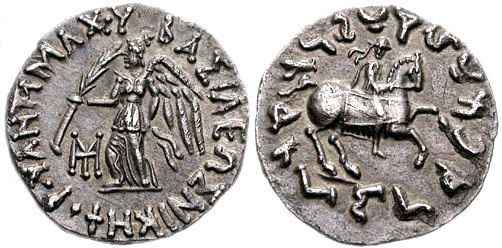Antimachus II on:
[Wikipedia]
[Google]
[Amazon]
Antimachus II Nikephoros (
 Antimachus II did not strike a portrait on his coins, likely since this was not custom in India. Neither did the early kings strike tetradrachms. Antimachus II struck a large number of bilingual drachms on the same lighter Indian standard as Apollodotus I, though round in shape. On the obverse is
Antimachus II did not strike a portrait on his coins, likely since this was not custom in India. Neither did the early kings strike tetradrachms. Antimachus II struck a large number of bilingual drachms on the same lighter Indian standard as Apollodotus I, though round in shape. On the obverse is
Greek
Greek may refer to:
Anything of, from, or related to Greece, a country in Southern Europe:
*Greeks, an ethnic group
*Greek language, a branch of the Indo-European language family
**Proto-Greek language, the assumed last common ancestor of all kno ...
: ; the epithet
An epithet (, ), also a byname, is a descriptive term (word or phrase) commonly accompanying or occurring in place of the name of a real or fictitious person, place, or thing. It is usually literally descriptive, as in Alfred the Great, Suleima ...
means "the Victorious") was an Indo-Greek
The Indo-Greek Kingdom, also known as the Yavana Kingdom, was a Hellenistic period, Hellenistic-era Ancient Greece, Greek kingdom covering various parts of modern-day Afghanistan, Pakistan and northwestern India.
The term "Indo-Greek Kingdom" ...
king. He ruled a vast territory from the Hindu-Kush
The Hindu Kush is an mountain range in Central and South Asia to the west of the Himalayas. It stretches from central and eastern Afghanistan into northwestern Pakistan and far southeastern Tajikistan. The range forms the western section of ...
to the Punjab
Punjab (; ; also romanised as Panjāb or Panj-Āb) is a geopolitical, cultural, and historical region in South Asia. It is located in the northwestern part of the Indian subcontinent, comprising areas of modern-day eastern Pakistan and no ...
around 170 BCE. He was almost certainly the eponymous son of Antimachus I, who is known from a unique preserved tax receipt. Osmund Bopearachchi
Osmund Bopearachchi (born 1949) is a Sri Lankan historian and numismatist who has specialized notably standardized the coinage of the Indo-Greek and Greco-Bactrian kingdoms. He is currently Emeritus Director of the CNRS at the École normale supé ...
dated Antimachus II to 160–155 BCE on numismatical grounds, but changed this to 174–165 BCE after the tax receipt was revealed to synchronise his reign with that of Antimachus I.Boperarachchi (1991) and (1998), respectively. R. C. Senior has not dated Antimachus II but thinks that his coins were possibly Indian issues of Antimachus I, despite their different epithets and coin types.
In both of Boperachchi's reconstructions, Antimachus II was succeeded by Menander I
Menander I Soter (, ; ), sometimes called Menander the Great, was an Indo-Greek king (reigned /155Bopearachchi (1998) and (1991), respectively. The first date is estimated by Osmund Bopearachchi and R. C. Senior, the other Boperachchi –1 ...
who inherited three of his four monograms. Antimachus II probably fought against the Greco-Bactrian king Eucratides I
Eucratides I (, ''Eukratídēs''; Pali: ''Evukratida''; reigned 172/171–145 BC), also known as Eucratides the Great, was one of the most important Greco-Bactrian kings. He conquered large parts of northern India, and minted a vast and pre ...
, who had dethroned his father in Bactria.
Coins of Antimachus II
 Antimachus II did not strike a portrait on his coins, likely since this was not custom in India. Neither did the early kings strike tetradrachms. Antimachus II struck a large number of bilingual drachms on the same lighter Indian standard as Apollodotus I, though round in shape. On the obverse is
Antimachus II did not strike a portrait on his coins, likely since this was not custom in India. Neither did the early kings strike tetradrachms. Antimachus II struck a large number of bilingual drachms on the same lighter Indian standard as Apollodotus I, though round in shape. On the obverse is Nike
Nike often refers to:
* Nike, Inc., a major American producer of athletic shoes, apparel, and sports equipment
* Nike (mythology), a Greek goddess who personifies victory
Nike may also refer to:
People
* Nike (name), a surname and feminine giv ...
, and on the reverse a king on horseback.
He also issued bilingual bronzes with aegis
The aegis ( ; ''aigís''), as stated in the ''Iliad'', is a device carried by Athena and Zeus, variously interpreted as an animal skin or a shield and sometimes featuring the head of a Gorgon. There may be a connection with a deity named Aex, a ...
/ laurel wreath
A laurel wreath is a symbol of triumph, a wreath (attire), wreath made of connected branches and leaves of the bay laurel (), an aromatic broadleaf evergreen. It was also later made from spineless butcher's broom (''Ruscus hypoglossum'') or cher ...
and palm. Both these and the goddess Nike seem to allude to his epithet ''"the Victorious".''
See also
*Greco-Buddhism
Greco-Buddhism or Graeco-Buddhism was a cultural syncretism between Hellenistic culture and Buddhism developed between the 4th century BC and the 5th century AD in Gandhara, which was in present-day Pakistan and parts of north-east Afghanis ...
*Indo-Scythians
The Indo-Scythians, also known as Indo-Sakas, were a group of nomadic people of Iranic Scythian origin who migrated from Central Asia southward into the present-day regions of Afghanistan, Eastern Iran and the northwestern Indian subcontinent: p ...
Notes
Sources
* * *"Sylloge Nummorum Graecorum 9", American Numismatic Society, New York, 1997. {{DEFAULTSORT:Antimachus 02 Greco-Bactrian kings 2nd-century BC monarchs in Asia Euthydemid dynasty